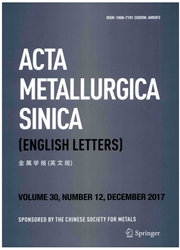

 中文摘要:
中文摘要:
In this paper, an improved sol-gel method was suggested to obtain high-concentration LiTaO3 precursor solution for simplified experimental conditions and thicker films, by mixing lithium acetate and tantalum ethoxide in a 1, 2-Propylene glycol solution. Compared to traditional methods, the process was done without weak acidic solution and absolute dry experimental condition. Results of a comparative study of LiTaO3 thin films derived by the improved sol-gel process and a traditional process using 2-methoxy ethanol as solvent were presented. Nano-crystalline LiTaO3 films with rhombohedral structures were formed in both methods after annealing at 650℃ for 5 min. The thickness of each LiTaO3 layer coated onto the substrate increased from 25 nm to 110 nm when 2-methoxy ethanol was replaced by 1, 2-Propylene glycol. LiTaO3 films with a stronger preferential orientation were obtained in 1, 2-Propylene glycol due to its higher boiling point and slower volatilization rate. On the other hand, the diffraction peak intensity of LiTaO3 thin films prepared using 1, 2-Propylene glycol was weaker than that of the films prepared using 2-methoxy ethanol due to decreased times of annealing.
 英文摘要:
英文摘要:
In this paper, an improved sol-gel method was suggested to obtain high-concentration LiTaO3 precursor solution for simplified experimental conditions and thicker films, by mixing lithium acetate and tantalum ethoxide in a 1, 2-Propylene glycol solution. Compared to traditional methods, the process was done without weak acidic solution and absolute dry experimental condition. Results of a comparative study of LiTaO3 thin films derived by the improved sol-gel process and a traditional process using 2-methoxy ethanol as solvent were presented. Nano-crystalline LiTaO3 films with rhombohedral structures were formed in both methods after annealing at 650℃ for 5 min. The thickness of each LiTaO3 layer coated onto the substrate increased from 25 nm to 110 nm when 2-methoxy ethanol was replaced by 1, 2-Propylene glycol. LiTaO3 films with a stronger preferential orientation were obtained in 1, 2-Propylene glycol due to its higher boiling point and slower volatilization rate. On the other hand, the diffraction peak intensity of LiTaO3 thin films prepared using 1, 2-Propylene glycol was weaker than that of the films prepared using 2-methoxy ethanol due to decreased times of annealing.
 同期刊论文项目
同期刊论文项目
 同项目期刊论文
同项目期刊论文
 Preparation and Characterization of Lithium Tantalate Thin Films using a High-concentration Precurso
Preparation and Characterization of Lithium Tantalate Thin Films using a High-concentration Precurso Phosphorescent Molecularly Doped Light-Emitting Diodes with Blended Polymer Host and Wide Emission S
Phosphorescent Molecularly Doped Light-Emitting Diodes with Blended Polymer Host and Wide Emission S Improving Light Outcoupling Efficiency for OLEDs with Microlens Array Fabricated on Transparent Subs
Improving Light Outcoupling Efficiency for OLEDs with Microlens Array Fabricated on Transparent Subs 期刊信息
期刊信息
